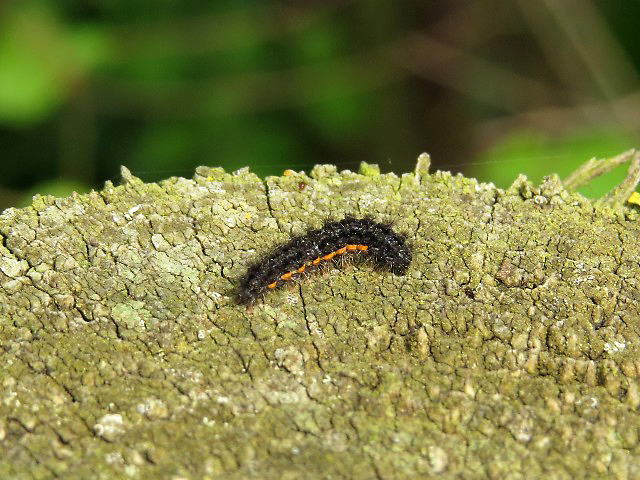This morning me and the old ruins (sorry ladies) headed to visit another old ruin, Corfe Castle. I wasn't expecting to see much in the way of wildlife but me being me I kept my eyes peeled and actually saw a few interesting bits and pieces between the showers. The highlight being a Wall butterfly that was flitting around the remains of the keep. Also of interest was a family of Ravens (including 2 juveniles) that were perched up on the highest point of the castle.
Juvenile Ravens at Corfe Castle
Monday 12th May (evening) - Hartland Moor
This evening I went solo and decided to pay a visit to the Stoborough side of the moor just before dusk. I was hoping to hear a Nightjar churring as it went dark but alas no such joy. That said earlier that evening I had some cracking views of a ♂ Dartford Warbler singing away from a gorse bush, flushed a Woodlark and had a close encounter with a Sika Deer. Then bit later on I saw a nice herd of Sika feeding on the short lawns on the NE edge of Stoborough Heath. They looked resplendent in the evening sunshine whilst the sound of a nearby Cuckoo calling filled the air...magical. I really do love lowland heaths!
Sika Deer (Cervus nippon)
Sika Deer Herd - Stoborough
Click on image to enlarge
Dartford Warbler (Sylvia undata) ♂
Tuesday 13th May (am) - RSPB Radipole Lake
This morning we visited the RSPB's Radipole Lake Reserve. This reserve really is a bit of a wildlife oasis situated in the heart of Weymouth. The reserve was full of the sound of singing warblers with the Reed Warblers being particularly vocal. Every so often we were also treated to the explosive call of one of the reserves many Cetti's Warblers. A Sandwich Tern was out fishing over the open water.
The highlight for me though was getting cracking views of the ♂ Marsh Harrier hunting quite close over the reed bed. The ♀ Harrier also put in an appearance. From the hide I also found a cracking ♂ Whinchat flitting down to ground in typical chat fashion from a scrubby bush.
Whinchat ♂ (record shot)
By the visitors centre we were treated to good views of a party of Bearded Tits that came through (although none wanted to pose for the camera). On the island opposite a Common Sandpiper was working it's way along the shore line.
Bearded Tit..."No, I won't pose for a photo!"
Tuesday 13th May (pm) - RSPB Lodmoor
In the afternoon we undertook a walk around the RSPB's other Weymouth reserve, Lodmoor. Lodmoor is situated on the edge of the town and boasts a mosaic of reed bed, open water, saltmarsh, wet grassland and scrub.
We didn't add any new birds to the day's tally but with the sun shining it was a good walk for Inverts. A highlight being some really fresh looking Wall butterflies. The Wall (or Wall Brown as it is sometimes known) used to be a fairly common butterfly across the country but the population crashed during the last 20 years and now it is predominately a coastal butterfly. It is very scarce now in my native Central England with just small populations dotted about at a handful of quarried sites. It get's it's name from basking on walls, rocks and stony places.
Wall (Lasiommata megera)

An immature Broad-bodied Chaser was showing well and a number of moth larvae were found including The Drinker, The Lackey & Scarlet Tiger were encountered during the walk.
Broad-bodied Chaser (Libellula depressa)
Scarlet Tiger (Callimorpha dominula) larva
The Lackey (Malacosoma neustria) larva












+2+-+Hartland+Moor,+Dorset,+11th+May+2014.jpg)
++larva+-+Hartland+Moor,+Dorset,+11th+May+2015.jpg)








+female+-+Penny+Hill+Bank,+5th+May+2014+(2).jpg)
+-+Penny+Hill+Bank,+5th+May+2014+(2).jpg)


+&+Greater+Stitchwort+(Stellaria+holostea)+ed+-+Caddesley+Woods+NNR,+29th+April+2014.jpg)
+-+Chaddesley+Woods,+29th+April+2014.jpg)







